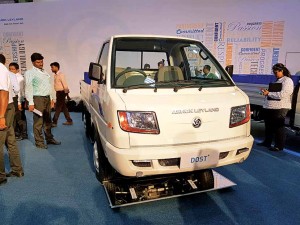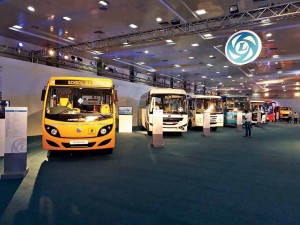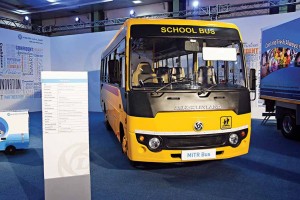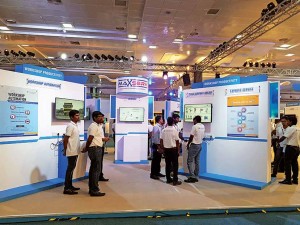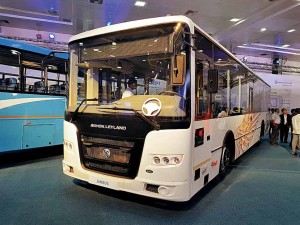Ashok Leyland has developed iEGR for its CVs to comply with BSIV emission regulations.
Story by:
Bhushan Mhapralkar
Ashok Leyland achieved the feat of complying with BSIII emission regulations when they were enforced in 2010 with an in-line mechanical fuel pump. The fuel governing system of the engine was suitably tweaked. To meet the BSIV emission norms that came into force pan-India from April 01, 2017, the commercial vehicle manufacturer has taken the Exhaust Gas Recirculation (EGR) route. It has developed what it would like to term as intelligent Engine Gas Recirculation (iEGR). Rather than adapt a Selective Catalytic Reduction (SCR) system, the company chose to tweak the engine combustion management system and EGR of both its engine families – H and N, that range between 130 hp and 400 hp. Announced Vinod K. Dasari, Managing Director and CEO, Ashok Leyland, that the technology was developed over four years, and with the view of eliminating challenges pertaining to SCR system in terms of weight and operational costs. Claiming that his were the only company in the world to comply with BSIII emission norms using a mechanical pump, Dasari mentioned, “Better fuel efficiency (of up to 10 per cent), and reliability from the absence of SCR associated electronics are the two outcomes of the iEGR endeavour.” With the elimination of POC, and additional sensors, the BSIV trucks, the company offers, promise to deliver higher payload because of the weight saved. Stating that they have been offering SCR since 2010, and came to conclude that it is useful in long runs at constant speeds, Dasari averred, “India is a value conscious market.” What makes iEGR interesting is the low acquisition cost of the vehicle as compared to the one that is equipped with a SCR system.
Impact of SC order
Like other Indian automakers, Ashok Leyland was also affected by the Apex Court’s order to stop selling BSIII vehicles beginning April 01, 2017. Not the one to push inventory on to its dealers, the company, according to Dasari, was left with 10,664 BSIII CVs. “It was panic”. “The successful development of iEGR over the last four years helped us to retain our confidence,” said Dasari. A decision to swap the BSIII engines in BSIII CVs was taken. The engines taken out will be sold in the aftermarket, mentioned Dasari. He claimed that no major financial impact was had, and even though the development was painful. “It is a pain, not fun, but we will get over it,” averred Dasari. Till date, 220 BSIII CVs have been converted to BSIV. The cost of swapping the engine per vehicle is roughly Rs.20,000. The BSIII engine costs Rs.1.4 lakh according to Dasari. In the aftermarket, it is expected to fetch a price of Rs.2.2 lakh. Ashok Leyland vehicles, expressed Dasari, are virtually sold on cash and carry basis.
Risk aversion
An endeavour to invade new markets overseas has proved to be of much use to Ashok Leyland in its effort to averse risk. With the Indian market showing signs of much cyclicity off late, the company, which according to Dasari, is the ninth largest truck maker and fourth largest bus maker in the world, is looking at increasing its export thrust. Said Rajive Saharia, President – Global Sales and Distribution, that the company is keen to export one CV for every two CVs sold in the domestic market. Expressed T Venkataraman, Senior Vice President – Global Bus, that the domestic and export sales ratio as far as buses are concerned is 58:42. Buses are exported, he averred, to the Middle East, SAARC, and African markets. Stressing upon the next quarter looking tough, Venkataraman expressed, “We are supplying Euro 5 vehicles to Ukraine, and are going to Latin America.” Quipped Saharia, that more trucks were sold overseas last year than buses. “ Close to 60 per cent of export sales was through trucks,” announced Saharia. The company is looking forward to export LCVs. When it does, the exercise would help it to inch closer to the target of exporting one CV for every two CVs sold in India. Apart from the Middle East, SAARC and African markets, Ashok Leyland is looking at Russia and Ukraine too. In an effort to arrive at streamlined manufacturing processes and higher efficiency, Ashok Leyland has replicated the Ras Al Khaimah plant at Bangladesh. A 200 to 300 unit market will make an attractive export market (in Bangladesh) according to Saharia.
If Bangladesh is the largest truck export market for Ashok Leyland, the company has began exporting the Boss to Russia. Said Saharia, “Supply of bus kits to Ukraine is on, and local converters are building bodies on them.” Ashok Leyland’s strategy to averse risk and grow faster than the industry reflects from its decision to exit some of the STU businesses. This, for a leading bus player in the country was not an easy task. Said Dasari, “We exited some STU businesses for low profitability.” In its quest to put the Dollar where the returns are, Ashok Leyland made it a point to concentrate on innovative products. The result of this is the introduction of Captain, Guru, Circuit electric bus, Sunshine school bus with roll-over protection, and the Oyster (safest) school bus in the Gulf. Due to its growth potential, Ashok Leyland paid attention to the coal tipper and construction truck market.
Tapping growth
Selling over 200 Guru ICVs till date, Ashok Leyland witnessed good uptake in 10×2 and 8×2 mining tippers and construction trucks. It sold over 1500 units according to Dasari. The share of Ashok Leyland’s mining tipper and construction truck market, claimed Dasari, grew by 50 per cent over the industry average of 30 per cent. From the time it was launched, the company has sold over 3000 Sunshine school buses. There is a waiting list of 500 vehicles. Despite a single product (Dost), Ashok Leyland’s LCV portfolio, said Dasari, witnessed a growth of 4 per cent. Expressed Nitin Seth, President, LCV and Defence, “We are now looking at running faster. We will launch the passenger version of Dost followed by the bigger version of Dost called the Dost+. An eight-metre long bus on the Mitr platform will be introduced. We will also address the demand for 32-seater school bus and a CNG vehicle. These would be developed in left-hand drive variants as well by keeping in mind the export markets.” Ashok Leyland is keen to tap world’s 80 per cent LCV market that is left-hand drive oriented. To cater to the market for smaller buses, the left-hand drive Mitr will be Ashok Leyland’s ace card.
Apart from expanding the three LCV platforms the company currently has, the plan, according to Seth, is to develop new LCV platforms by 2019-2020. Well aware of the domestic LCV market turning eight-per cent positive for the first time this year, Seth is looking at hitting a six-lakh volume by 2021. Seth is also hoping the LCV to be a bigger player with the coming of GST. In the export markets, Seth is keen to leverage the fact that Nissan LCVs are marketed in many markets making them a familiar sight. With stress on filling up the gaps in the LCV product portfolio by developing new platforms, Ashok Leyland is looking at quadrupling the sale of LCVs with the Nissan joint venture behind it. Keen to sell one LCV for every two LCVs sold in the Indian market, the company is banking on Dost+, which offers a 1400 kg capacity and rides on 15-inch dia. wheels to further increase its LCV market share in the near future. The Dost+ comes equipped with six leaf spring suspension at the rear, and a four-leaf spring suspension at the front.
Defence business
Providing further impetus to its defence strategy, the supply of Stallion vehicle kits grew 7.4 per cent, from 3076 numbers to 3304 numbers. With an ambition to cater to 25 per cent of the defence budget, the company has invested in a new defence vehicle facility at its Ennore plant. Special focus is on catering to defence vehicle market. Close to 95 per cent of the UN peace keeping forces in Africa, informed Dasari, use Ashok Leyland vehicles. The company has received 4×4 mine protected vehicle order from the Indian Army, he revealed.
Investing in the right solutions
Happy with the genset volume growth of six per cent on the back of new product variants, Ashok Leyland has begun selling automotive engines. It has received first customer order from USA. Said Gopal Mahadevan, Chief Financial Officer, Ashok Leyland, “We have been doing away with all those inside processes, which do not add value to a shareholder, vendor, customer or a large investor. We are automating a lot of them, eliminating, and streamlining them. With limited resources, we have been judiciously investing employee cost in product development and marketing. Much focus is being paid to achieve a high rate of success.” Claiming that Ashok Leyland is one of the few companies in the world to possess sub-BSIII capabilities since it caters to such markets, Mahadevan averred, “We have BSIII in-line and common-rail tech, and we have BSIV EGR and SCR.”
Owning German SCR specialist Albonair, which supplies Euro6 SCR systems to Volvo, Ashok Leyland, it is surprising, chose to develop iegr rather than to deploy SCR. Said Dasari that stress was laid on offering what would best suit the Indian market. He gave an example of trucks being washed by the river-side with buckets of water. Expressed Mahadevan, “We are attributing growth to addressing the exacting needs of the market. We are the only manufacturer to increase the price of our products in January 2017 by four per cent. We are the only one to gain maximum market share in March 2017.” Averred Dasari that the company’s market share grew from 24 per cent to 32 per cent. Of the view that they have seen good growth despite hiking product prices, Gopal averred, the solutions we offer are about total cost of ownership. Working on multiple channels, Ashok Leyland, to tap growth, worked on increasing the points of presence. “50 to 1,600 is a disruptive force,” said Mahadevan. Putting money on channel expansion rather than discounts, the company concentrated on efficient breakdown services, he added. This, mentioned Gopal, was necessary because the vehicles sold by them are often misused, and are therefore prone to a breakdown.
Apart from investing in the channel, Ashok Leyland has also invested in new products. The Boss, Captain, Partner, Janbus, Mitr, Guru, and others are a point in case. The company leveraged technology to address the requirements of the customers at any given time. This helped the company to secure an order from USA. Claiming that dealers appreciated company’s policy to not push inventory, Gopal opined that a clear focus is on return on investment at Ashok Leyland when it comes to technology. He explained, “As far as technology is concerned, ours is the only electric bus that climbed the Rohtang pass without a breakdown.” Ashok Leyland is building its capabilities in parallel. It is digitising. Mentioned Rajive Saharia, that Ashok Leyland is banking on digital initiatives for growth.
Digitisation
Digitisation for Ashok Leyland, apart from common-rail engines, means telematics and a slew of ‘support’ technologies. Mentioned Dasari, “We developed a new way of providing telematics in the form of a single device that works on any Ashok Leyland vehicle, and without any kind of engine or associated architecture. It provides driver information, diagnostics, etc., and is found on BSIV CVs.” Ashok Leyland has developed a scan tool for onboard diagnostics for a fraction of a cost, and sans the need for a laptop. The company has also developed Ley Assist, which according to Dasari is a Bluetooth operated phone based tool to diagnose error without any physical connection. Looking at autonomous vehicles and vehicle platooning technologies as the future, the folks at Ashok Leyland are working in that direction, albeit with limited resources. Expressed Mahadevan, “I have limited Dollars, and I am spending them efficiently.” “Our net price realisation in March was better than in February, and it is something that is hard to believe but true,” he added. Ashok Leyland is paying attention on logistics and supply chain. It is also paying attention to improve the capabilities of tier 2 suppliers. Revealed Mahadevan that stress is on pertinent technology; technology that will sell. “We are thus keen to build an engine portfolio, and turn it into a separate line of business. A lot of our engines are used for marine applications besides gensets,” he signed off.





